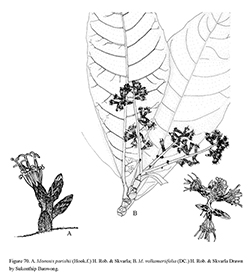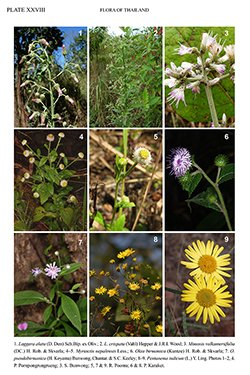e-Flora of Thailand
Volume 13 > Part 2 > Year 2016 > Page 362 > Compositae (Asteraceae) > Monosis
2. Monosis volkameriifolia (DC.) H.Rob. & Skvarlawfo-0000055383
Proc. Biol. Soc. Washington 119(4): 606. 2006; Bunwong, Chantar. & S.C.Keeley, PhytoKeys 37: 87. 2014.— Vernonia volkameriifolia DC., Prodr. 5: 32. 1836. Fig. 70B; Plate XXVIII: 3.
Accepted Name : This is currently accepted.
Synonyms & Citations :
Description : Small tree, 3–6 m tall; stem erect, bark grey, young branches inconspicuously ribbed, white tomentose. Leaves obovate or oblanceolate, 10–50 by 5–20 cm, apex acute, base cuneate, margins serrate, coriaceous, upper surface whitish puberulous, without glands, lower surface whitish puberulous with flagellate hairs and capitate glands, lateral veins 10–20 pairs; petioles to 3 cm long. Inflorescences terminal, thyrsoid paniculate. Capitula campanulate, 9–10 mm long, subsessile or shortly pedunculate; involucres narrowly campanulate or slightly oblong-cylindrical; phyllaries 4- or 5-seriate, imbricate, light green or purple apically, 4–5 by 2–3 mm, margins piliferous or entire, outer surface white arachnoid without glands, outer and middle phyllaries ovate, apex acute, inner ovate or lanceolate, apex acute; receptacle flat, 1.5–2 mm diam., glabrous. Florets 8–10; corollas funnelform, purple, glandular, basal tubes 5.5–6 mm long, lobes 2–3 mm long; anthers 3–3.5 mm long, apical appendage acute, base acute; styles purple, 5–7 mm long, branches 2, 3–4 mm long. Achenes turbinate, 4–5 mm long, 10-ribbed, densely setuliferous, setulae of twin hairs, and capitate glands; pappus biseriate, inner setae 7–8 mm long.
Thailand : NORTHERN: Mae Hong Son, Chiang Mai, Lamphun, Lampang.
Distribution : China (Yunnan), India, Bhutan, Myanmar, Vietnam.
Ecology : Hill evergreen or pine-oak forests, 500–1,750 m alt. Flowering: November–March.
Vernacular : Khla-po-pha-du (คละ-ปอ-พะ-ดุ)(Karen-Chiang Mai), ya kae (ยาแก้, หญ้าแก้), mahok ton (มะโหกต้น), yan (หยาน)(Chiang Mai).
Notes: Monosis volkameriifolia is similar to M. parishii in capitula and leaf shape but differs in being a tree, not a shrub and in having whitish puberulous, not ferrugineous tomentose leaf surfaces.


